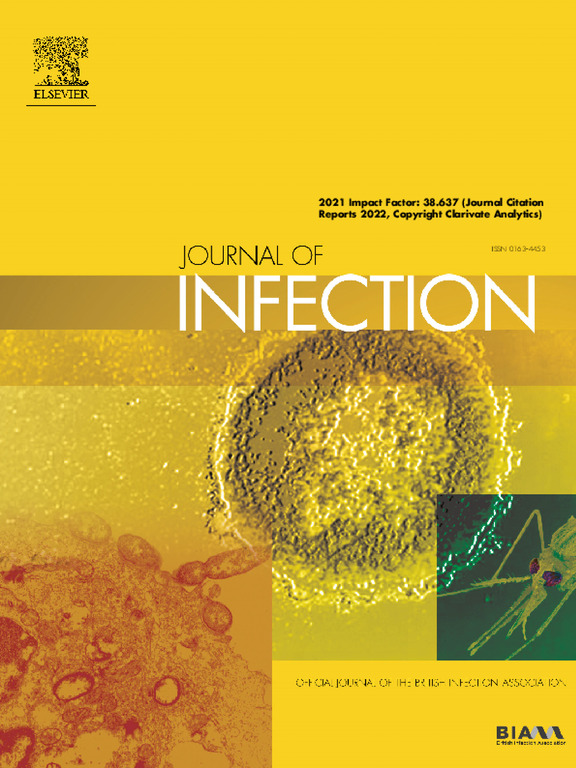Carriage of Streptococcus pneumoniae in adults hospitalised with community-acquired pneumonia
IF 14.3
1区 医学
Q1 INFECTIOUS DISEASES
引用次数: 0
Abstract
Objectives
We aimed to determine the prevalence of and risk factors for nasopharyngeal and oral pneumococcal carriage in adults with community-acquired pneumonia (CAP), and the relationship between carried and disease-causing serotypes.
Methods
Between 2016 and 2018, nasopharyngeal swabs, oral-fluid, and urine were collected from hospitalised adults recruited into a prospective cohort study of CAP. Pneumococcal carriage was detected by semi-quantitative real-time PCR of direct and culture-enriched nasopharyngeal swabs and culture-enriched oral-fluid. LytA and piaB positive/indeterminate samples underwent semi-quantitative serotype/serogroup-specific real-time-PCR. Serotypes in urine were identified using a 24-valent serotype-specific urinary-antigen assay.
Results
We included 465 CAP patients. Nasopharyngeal carriage was detected in 34/103 (33.0%) swabbed pneumococcal pneumonia patients and oral carriage in 18/155 (12%) of sampled pneumococcal pneumonia patients. Concordance between nasopharyngeal/urine serotypes and oral/urine serotypes was 70.6% and 50% respectively. Serotypes 3 (26%, 22.2%), 8 (19.7%, 19.4%), non-typeable (11.6%, 13.9%) and 19A/F (7.5%, 8.3%) were most prevalent in urine and nasopharyngeal swabs respectively, with non-typeable (35%) and 15A/F (17%) most prevalent in oral-fluid. Pneumococcal carriage was significantly associated with pneumococcal pneumonia (nasopharyngeal adjusted odds ratio [aOR] 8.1, 95% confidence interval [CI] 3.8–17.2; oral aOR 5.5, 95% CI 2.1–13.3). All-cause CAP patients ≥65 years had lower odds of nasopharyngeal carriage (aOR 0.47, 95% CI 0.24–0.91) and current smokers had higher odds of oral carriage (aOR 2.69, 95% CI 1.10–6.60).
Conclusions
The association between nasopharyngeal carriage and pneumococcal CAP was strong. Adult carriage and disease from serotypes 8 and 19A may support direct protection of adults with PCV vaccines.
因社区获得性肺炎住院的成人中肺炎链球菌的携带情况。
目的我们旨在确定社区获得性肺炎(CAP)成人中鼻咽和口腔肺炎球菌携带的流行率和风险因素,以及携带与致病血清型之间的关系:2016年至2018年期间,一项CAP前瞻性队列研究收集了住院成人的鼻咽拭子、口腔液和尿液。通过半定量实时 PCR 检测直接鼻咽拭子、富含培养物的鼻咽拭子和富含培养物的口腔液中的肺炎球菌携带情况。对 LytA 和 piaB 阳性/不确定样本进行半定量血清型/同种群特异性实时 PCR 检测。尿液中的血清型采用 24 价血清型特异性尿抗原检测法进行鉴定:我们共纳入了 465 名 CAP 患者。在 34/103 例(33.0%)肺炎球菌肺炎拭子患者中检测到鼻咽带菌,在 18/155 例(12%)肺炎球菌肺炎采样患者中检测到口腔带菌。鼻咽/尿液血清型与口腔/尿液血清型的一致性分别为 70.6% 和 50%。血清型 3(26%,22.2%)、8(19.7%,19.4%)、不可分型(11.6%,13.9%)和 19A/F(7.5%,8.3%)分别在尿液和鼻咽拭子中最常见,而不可分型(35%)和 15A/F(17%)在口腔液中最常见。肺炎球菌携带与肺炎球菌肺炎有显著相关性(鼻咽部调整比值比 [aOR] 8.1,95% 置信区间 [CI] 3.8-17.2;口腔部调整比值比 [aOR] 5.5,95% 置信区间 [CI] 2.1-13.3)。年龄≥65岁的全因CAP患者鼻咽带菌几率较低(aOR为0.47,95% CI为0.24-0.91),目前吸烟者口腔带菌几率较高(aOR为2.69,95% CI为1.10-6.60):结论:鼻咽带菌与肺炎球菌CAP之间的关系密切。血清型 8 和 19A 的成人携带和疾病可能支持用 PCV 疫苗直接保护成人。
本文章由计算机程序翻译,如有差异,请以英文原文为准。
求助全文
约1分钟内获得全文
求助全文
来源期刊

Journal of Infection
医学-传染病学
CiteScore
45.90
自引率
3.20%
发文量
475
审稿时长
16 days
期刊介绍:
The Journal of Infection publishes original papers on all aspects of infection - clinical, microbiological and epidemiological. The Journal seeks to bring together knowledge from all specialties involved in infection research and clinical practice, and present the best work in the ever-changing field of infection.
Each issue brings you Editorials that describe current or controversial topics of interest, high quality Reviews to keep you in touch with the latest developments in specific fields of interest, an Epidemiology section reporting studies in the hospital and the general community, and a lively correspondence section.
 求助内容:
求助内容: 应助结果提醒方式:
应助结果提醒方式:


